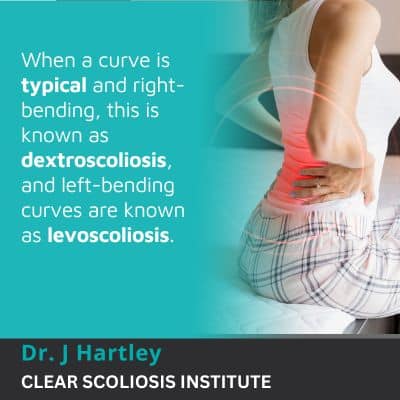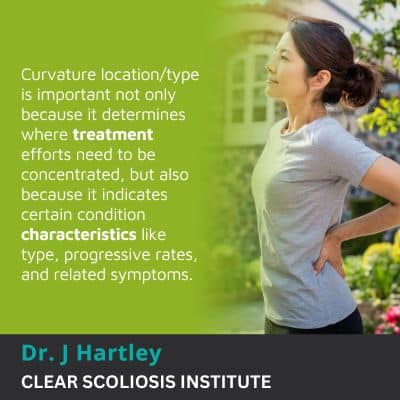
Part of the reason scoliosis is considered a complex spinal condition to treat is because each case is unique; there are a number of patient and condition variables that shape a patient’s experience of life with the condition, and curvature type is an important factor.
Not only are there different types and severity levels of scoliosis, the unnatural spinal curve also has different types and characteristics. From where along the spine the curvature is located to the direction in which it bends, these factors help shape treatment.
As part of diagnosing scoliosis involves comprehensive assessment and classification, let’s start with how scoliosis is diagnosed and classified.
As scoliosis varies so much from patient to patient, treatment plans need to be fully customized to address key patient and condition characteristics.
To diagnose scoliosis, an unnatural lateral (side-to-side) curvature of the spine has developed that also twists, and it’s the spine’s rotation that makes it a 3-dimensional spinal condition that needs to be addressed as such in treatment.
In addition, to be considered a true scoliosis, the size of the unnatural spinal curve has to be a minimum of 10 degrees, and this is determined by a measurement known as Cobb angle.
Part of the diagnostic process involves assessing conditions so they can be fully classified, and this streamlines the treatment process and informs the customization of treatment plans.

Patient age is important because as a progressive condition triggered by growth, how much growth a patient has to go through before reaching skeletal maturity helps predict potential progression; in addition, as scoliosis doesn’t become a compressive condition until skeletal maturity has been reached, this is when conditions commonly become painful, and while scoliosis isn’t commonly painful for children, it is for adults.
So patient age also determines whether pain management is likely to be a necessary component of treatment or not.
Condition type is important because when known, a condition’s underlying cause has to shape the focus of treatment, and condition severity is key because it informs the customization of treatment plans, in addition to indicating likely symptoms; the more severe scoliosis is, the more noticeable its effects are likely to be.
And in addition to patient age, condition type, and severity, curvature location/type is important.
A healthy spine consists of vertebral bodies (bones) stacked on top of one another in a straight alignment, and adjacent vertebrae are separated by an intervertebral disc; the discs are key to spinal health.
The intervertebral discs act as the spine’s shock absorbers, they provide cushioning to prevent friction, give the spine structural support, and combine forces to facilitate spinal flexibility and range of motion.
The spine has three main sections; the cervical spine refers to the neck, and the thoracic spine includes the middle/upper back, while the lumbar spine refers to the lower back.
Each spinal section has its own healthy curvature type that makes the spine bend inwards towards the body’s center (lordosis), or outwards, away from the body’s center (kyphosis), and the health of each spinal section is dependent on the health of the others.
The thoracic spine is kyphotic, while the cervical and lumbar sections are lordotic.
If the spine loses one or more of its natural and healthy curves, they are replaced by unhealthy curves, and this makes the spine weaker, less flexible, and disrupts its ability to evenly absorb/distribute mechanical stress.

So curvature location is classified as either cervical, thoracic, or lumbar scoliosis, or in the case of a combined scoliosis, like thoracolumbar scoliosis, for example, the curve has developed in the upper lumbar spine and the lower thoracic spine.
Curvature location/type is important not only because it determines where treatment efforts need to be concentrated, but also because it indicates certain condition characteristics like type, progressive rates, and related symptoms.
With most spinal conditions, the area of the body immediately surrounding an affected spinal section is the most likely to feel the condition’s direct effects; for example, in cases of lumbar scoliosis, a common effect is sciatic nerve pain, and this is because the sciatic nerve starts in the lower back.
If the lumbar spine’s unnatural bend and twist is compressing the sciatic nerve, pain and/or a variety of sensations can be felt anywhere along the nerve’s extensive pathway.
In addition to different curvature locations, curvature characteristics also vary, including the direction in which they bend.
When a scoliosis X-ray is performed, the direction of the bend is important.
Condition type is determined by causation, and in most cases of typical idiopathic scoliosis, which accounts for approximately 80 percent of known diagnosed cases, the cause is unknown and curves bend to the right, away from the heart (dextroscoliosis).
In atypical cases with known causes, curves can bend to the left in a ‘C’ shape, towards the heart (levoscoliosis ), and when I see a left-bending curve, this indicates there’s an underlying pathology causing the scoliosis onset.
Scoliosis types with known causes include neuromuscular scoliosis, congenital scoliosis, and degenerative scoliosis.
Neuromuscular scoliosis (NMS) is caused by the presence of a larger neuromuscular condition, and congenital scoliosis is caused by the spine not forming properly in utero, and degenerative scoliosis is caused by natural age-related spinal degeneration and the cumulative effect of certain lifestyle factors.
When a curve is typical and right-bending, this is known as dextroscoliosis, and left-bending curves are known as levoscoliosis.
There are also instances where double curves develop.
A double scoliosis curve is also known as an ‘S’ curve because the unnatural curvature bends in two directions, while most typical single idiopathic curves are ‘C’ shaped.
So a spine with an S-shaped curve will have two unnatural spinal curves, and location is best assessed by what’s known as the plumbline.
Each curve has to be classified, with one determined as the major curve (larger) and the other as the minor curve.
In cases of a double scoliosis, one curve will always be dominant, and when it comes to lumbar scoliosis, these curves are often larger than the curves that develop in the thoracic spine.
Various curvature types and patterns have been well documented over the years, so we know what the most common curvature types are.
Single curves developing in the thoracic spine are the most common, accounting for approximately 37 percent of cases.
Single lumbar curves account for approximately 30 percent, while double major curves account for 13 percent, and single thoracolumbar curves account for 30 percent also; double thoracic curves account for 6.6 percent.
The most common types of scoliosis cures are right thoracic curves, accounting for approximately 28 percent and left lumbar curves accounting for 22 percent.
Each spinal section has its own characteristic curvature type and roles to play in maintaining general spinal health and function; the cervical spine supports the weight of the neck, the head, and facilitates the neck’s flexibility and range of motion.
The thoracic spine is the largest spinal section and the only one that’s attached to the rib cage, so the middle/upper back can be affected by a number of spinal conditions/issues, and we know that thoracic scoliosis commonly causes the development of a rib cage arch.
The lumbar spine has the added role of supporting the weight of the spinal sections above, the entire trunk, and its vertebrae feel the strain of bending, lifting, and twisting, which is why it’s said that everyone will experience lower back pain at some point in their lives.
Here at the CLEAR Scoliosis Institute, comprehensive classification of conditions is part of the diagnostic process so treatment plans can be fully customized, and a conservative chiropractic-centered treatment approach is proactive because it can be started immediately following a diagnosis, when it’s most likely to respond well; scoliosis gets more complex to treat the more it progresses.
Remember, as a progressive condition, scoliosis severity will change over time; where a patient’s scoliosis is when it’s first diagnosed doesn’t mean it will remain at that severity level, particularly without treatment.
As a condition that’s always changing, it’s important that treatment can be adjusted accordingly, and this involves apportioning treatment disciplines based on how the spine responds to growth and treatment.
While there are no treatment guarantees, regardless of patient age, condition type, severity, or curvature type, there are a number of benefits to being proactive with treatment because although progressive, scoliosis can be highly responsive and manageable.

CLEAR provides a unique and innovative way of understanding scoliosis. Sign up to receive facts and information you won’t find anywhere else.
